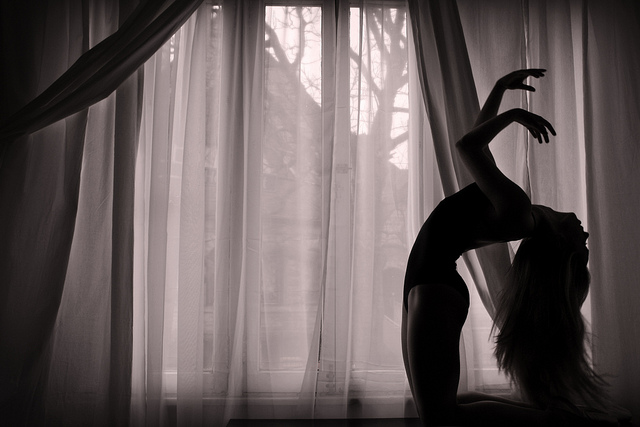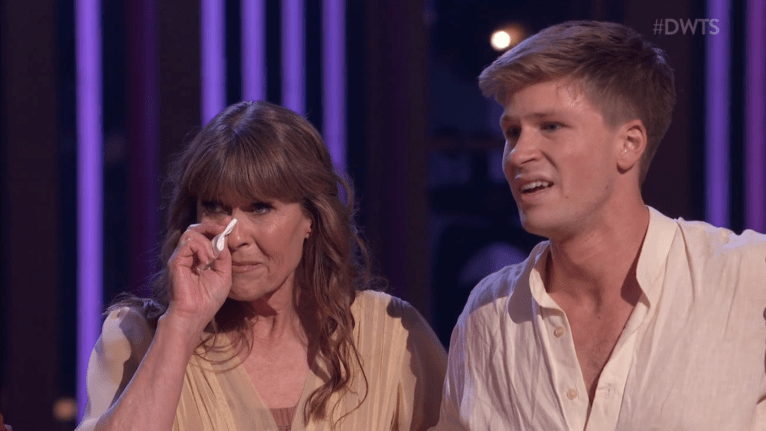
Dance And Eating Disorders: The Search For The Perfect Form
I stopped dancing around the same time I decided to stop starving myself. If I was really going to kick my eating disorder, if I was really going to, in the cringe-inducing terms of the body love movement, “make friends with my body,” it probably wasn’t a good idea, I figured, to put it in…
By ![]() Chloe Angyal
Chloe Angyal
Bless me, Balanchine, for I have sinned. It’s been over a year since my last dance class.
My parents put me in dance class almost as soon as I could walk, almost 25 years ago. Except for the three or so years I spent in an exclusive, head-over-heels relationship with gymnastics, I’ve spent my entire life going to dance class: ballet, jazz, lyrical, theatre jazz, and, when the powers that be in my college dance company forced me to, hip hop. I brush my teeth standing on my tiptoes. When I sit down on the floor, I automatically point my toes, without even thinking about it. I find it very, very hard to sit still when music — any music at all — is playing. I am that annoying woman you sit next to on the subway who just. Won’t. Stop. Moving.
Last summer, I spent two months in Paris working on my doctoral dissertation, and while I was there, I decided to take as many ballet classes as I could. Growing up in Sydney, the ballet studio was where I learned my first smattering of French, as teachers explained that “plié” meant “bent” and “fondue” meant “melted” — which I suppose is still true even when the words are mangled by thick Australian accents. If I was going to spend a few months in the birthplace of ballet, I figured, it would be really something to hear the familiar terms pronounced, the old instructions issued, as they were meant to be. It helped that the ballet studio looked like something out of a Dégas painting. When I came back to New York City in the autumn, I kept going to class at Steps, a nearby studio that is an institution in the New York dance world. Hobbling out of my low level class, I’d sneak a look into the advanced class, where principal dancers from the American Ballet Theatre and New York City Ballet were gliding and spinning, sweating and frowning at themselves in the mirror. But that was a year ago, and I haven’t been back in the dance studio in what feels like forever. And you might be wondering why.
I stopped dancing around the same time I decided to stop starving myself. If I was really going to kick my eating disorder, if I was really going to, in the cringe-inducing terms of the body love movement, “make friends with my body,” it probably wasn’t a good idea, I figured, to put it in a leotard and spend many hours a week in a room full of mirrors.
The relationship between dance and eating disorders is well-documented by now. It’s a staple of every dance movie you’ve ever seen, from Center Stage to Black Swan. It’s hardly surprising that so many dancers, and especially ballerinas, have eating disorders: the dominant aesthetic in ballet is and has for some time been one that demands extreme slenderness. That aesthetic was Balanchine’s doing: the father of American ballet liked his women thin and once told his protégé Gelsey Kirkland not to eat less, but to eat nothing, to be as thin as he wanted her to be. Ballerinas are athletes, but they’re also artists, and they put the “line” first: most defenses of extreme thinness claim that ballet is simply more pleasing to the eye when the shapes made by a dancer’s body are uncluttered by fat and flesh. Of course, not all dancers have eating disorders, and there are plenty of people who starve themselves without having ever once worn a ballet slipper. But generally, there’s a fairly high correlation — unsurprising, given the body shape demanded by the discipline — and personally, while I was eating way too little and exercising way too much, ballet was bad news. Even in French.
So I left. I had just bought a new pair of pointe shoes, my first in years, because after my time in Paris, I was getting close to strong enough to go back up on pointe. They’re so damn pretty, and I was so excited to bleed all over them; pointe shoes never stay pretty for long, but that’s half the fun. I tucked them away in my closet, the soles half broken in and the satin nearly pristine. I decided not to go back to dance class until I could enjoy it, until I could think more about what my body was doing and less about how it looked. It was the healthy choice, but it broke my heart a little.
Today, I decided to go back. Well, in truth, I decided to back two weeks ago, but it took me a while to build up the courage. I’ve missed dancing so much that sometimes I feel like my body is going to burst out of my skin if I don’t do it. My eating disorder felt like denying and silencing a crucial, elemental part of me, but so did swearing off the dance studio.
Walking back into the studio after a year away for any other reason would have been daunting. Walking back in today, I knew I wasn’t just risking sore muscles or disappointment at how my technique had atrophied; I was risking slipping back toward the at once cloudy and crystal sharp place I was in when I critiqued my body in those French mirrors.
It wasn’t exactly a triumphant return. Dance technique atrophies quickly, and things that were easy last year had me flummoxed today. Dancers talk about their “centre,” their sense of balance, a kind of muscle memory connection that runs down their spine and allows them to throw their arms and legs around without falling over. I don’t know where my centre was today, but if I had to guess I’d say somewhere in Azerbaijan, because I wobbled and toppled and fell on more than one occasion. My high kicks? Not as high as I remember. My turns were sluggish, and my jeté was downgraded from grand to moyen.
But damn, it felt good. Not the parts where my legs were trembling with exhaustion fifteen minutes in, or where my feet were cramping, the tiny muscles in them having gone virtually unused for months. But the dancing itself, the choreography taught by teacher I’ve been taking class with since I was fifteen, felt like careening down a stretch of highway you’ve been driving every day for years.
It’s going to hurt like hell to walk tomorrow morning. My knees are bruised from throwing myself to the ground (this is what dancers euphemistically call “floor work”), and my muscles quite literally ache from my head — well, my upper neck — to my feet. I am disappointed at how much skill and strength I lost in a year, but here’s the thing: I was concentrating so hard on finding my centre, on willing my high kicks to get higher, on taking those highway curves at just the right angle, that I barely had time to look in the mirror. And I wasn’t thinking about the weight I’d gained in the last year. I was thinking about the time I’d lost. ![]()











